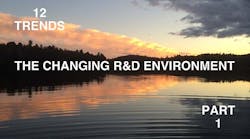Top 12 Trends in the Science of Managing R&D and Product Development: Part 1
This file type includes high-resolution graphics and schematics when applicable.
There are lots of trends and new ideas when it comes to the science of managing R&D. Some got started when a technological advance changed the best way to manage or make decisions. Others arose from new thinking in management science in the light of macro changes taking place in business and political structures, practices, and economics.
Below are six of the top 12 of these trends. As you read through the trends, keep "Big Data" in mind. It is a "macro trend" that will affect every industry and segment of the globe. It underlies more than half of the trends discussed, and, to a lesser extent, it will affect all 12. As an exercise, give some thought as to whether each trend is technology-driven or thinking-driven. In some cases, it’s both.
Trend 1. Rapid Prototyping (aka 3D printing): This is an example of a technology driving a change in management. It pulls certain activities like design reviews and some tactical and operational product decisions to the beginning of the development process. In a few more years, when the size/shape, material, and speed of 3D printing improve further, it will eliminate certain segments within industries. When "the death of operations" manifests, activities and decision making will surely be different.
Portfolio Management, for example, was a transformational trend in the late 1990s. It resulted from new management thinking about competing based on a better basket of goods than one's competitors. Shortly thereafter, portfolio-management software and know-how from the investment banking and insurance industries were adapted to the needs of corporate product and project portfolios.
Trend 2. Strategy: Globalization and shorter cycle times were the first salvos that began driving companies to be more flexible in the determination and deployment of strategy. Now natural events, politics, and economics are adding impetus. A few years ago, the U.S. Army coined "VUCA strategy," which stands for volatility, uncertainty, complexity, and ambiguity. VUCA is now making its way into business (HBR January-February).
Trend 3. Product Definition: Focus groups are proving increasingly inaccurate. Studies now show that what people say only loosely ties to what they finally decide. Decisions on product features are shown to be more accurate when based on monitoring the biological activity of the brain. Some consumer-goods companies are already making decisions based on people’s actual thoughts and desires.
Trend 4. Organic Innovation and Growth: Challenging economic conditions that have lasted consistently across three to five product development cycles led to a 50% decline in R&D spending, which has elevated risk ("Creating Bold Innovation In Mature Markets," Robert G. Cooper). Open innovation, alliances, and M&A activity have filled the voids for many. The organic inventory of "evolving and newly realized intellectual assets” will be rejuvenated in many industries, because this era competes on knowledge.
Trend 5. Search and Synthesis: The quest for a semantic web is coming ever closer to fruition. At some point in the next five-plus years, it will start to change corporations. Technical studies and market research that once took months will be reduced to days or hours. Confidence in the findings will also improve. Much more information will be available during early analysis and decision making. Just as drafting departments changed with the advent of solid modeling, so too will the structure of technical research and analysis change with semantic technology.
Trend 6. Core and Functional Competencies: Core competencies are the few things a company knows how to do that permeate its value in the marketplace. Functional competencies are the dozens of specific technical and business skill sets across marketing, engineering, materials, and production that get a product out the door. Both are changing. Every company will learn to add technology into its product and to position new capabilities "above" its products to maximize the connection and resultant value to its customers. Michael Porter's two Harvard Business Review articles make the point nicely (HBR November 2014 and October 2015). Industry is paying attention to this framework.
The remaining six trends will be discussed in my next column.


